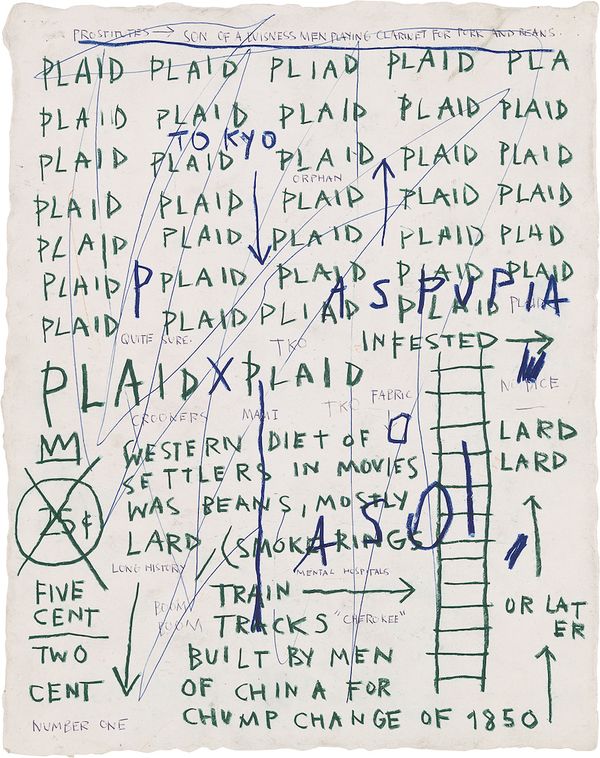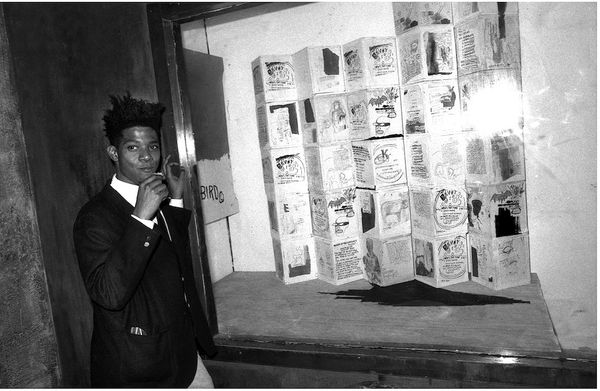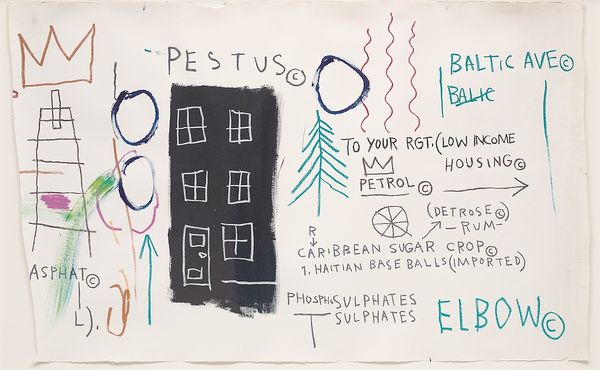Jean-Michel Basquiat, Untitled (Pestus), 1982. Estimate £2,000,000 - 3,000,000. 20th Century and Contemporary Art Evening Sale, London.

In what then became an iconic exchange between the curator Henry Geldzahler and the artist Jean-Michel Basquiat, the young, prodigious painter declared that the three themes defining his artistic intention were “royalty, heroism, and the streets.” Created in Basquiat’s milestone year of 1982, Untitled (Pestus) brilliantly encapsulates this threefold vision.
At the top of the composition, the word “PESTUS” floats over a black housing project, and is surrounded by the expressions “ASPHALT,” “SULPHATES,” and “BALTIC AVE.” Combining a distinctly urban vernacular with more idiosyncratic subjects, the work explores Basquiat’s proximity to the streets, which hosted the beginning of his career in New York City. This theme in turn reveals a natural implication of royalty and heroism, as arrows, waves, and other signs infer a movement from the bottom up, at once linguistically, iconographically, and socially.

Jean-Michel Basquiat, Untitled (Plaid), 1982, oil paintstick and ballpaper on paper, Whitney Museum of American Art, New York. © The Estate of Jean-Michel Basquiat / ADAGP, Paris and DACS, London 2020. Image: Adagp Images, Paris, / SCALA, Florence.
Prior to 1982—a breakthrough year marking the beginning of Basquiat’s intimate mythologies—the artist spent the majority of his time in New York’s Lower East Side, producing graffiti under the moniker SAMO (shorthand for “same old shit”). During this period, the artist shared a partnership with his friend Al Diaz, with whom he brandished anti-establishment messages regarding race, identity and commercialism on inner city buildings. These concerns remained alive as ever in Basquiat’s independent work developed at the dawn of the 1980s. In the present image, the artist clearly continues to deal with subjects of urban poverty, mass commodity, and the lack of resources employed to fix faulty structures in low-income neighbourhoods. With its clear, horizontal structure and its neatly delineated painterly elements, Untitled (Pestus) displays Basquiat’s perennial visual language, which, like the best of his work, encapsulates the crux of his observations.
Shortly before the execution of Untitled (Pestus), Basquiat’s art began garnering a number of critical accolades, including an invitation to participate in the landmark show New York/New Wave, which took place at the MoMA PS1 in February 1981, and congregated such influential artists as Keith Haring, Robert Mapplethorpe, Kenny Scharf, and Andy Warhol. From that moment onward, “All hell broke loose,” observed Richard Marshall. A result of newfound resources and increased artistic confidence, Untitled (Pestus) was painted a year after Basquiat had achieved cult status in the streets, and coincides with his progressive shift to gallery premises, enabled by the support of his new dealer Annina Nosei. At the age of 22, Basquiat impressed contemporary art critics with his natural flair, and cemented his status as New York’s “Radiant Child” —a title coined by Rene Ricard in the American poet’s Artforum article of 1981.

Ben Buchanan, Jean-Michel Basquiat in front of his window, 1985, black and white photograph. Image: Bridgeman Images.
Untitled (Pestus) contains a number of symbols and expressions that have concerned Basquiat during his all-too-short career. Most strikingly exposing the artist’s take on displacement and duality, the composition juxtaposes an essentially bare background with loose figurative signs. On the one hand, the work conveys the archetypical sensory experience of New York City’s busy streets through the use of heated colours and words; on the other, the artist mobilises references that are geographically distant, with expressions like “CARRIBEAN SUGAR” and “HAITIAN BASEBALL (IMPORTED).”
The thematic fragmentation contained within Untitled (Pestus) reflects the duality that Basquiat continuously negotiated throughout his life, manifested in the twofold cultural legacy he inherited from his parents, and the amalgamation of his conflicting personas in later years: a subversive artist on the one hand, and a successful painter attending to the lifestyle of New York’s creative elite on the other.
DIscover More from 20th Century and Contemporary Art Evening Sale, London >

Recommended Reading
Haring, Condo and Basquiat Masterworks to Benefit the Bedari Foundation >
In Lynette Yiadom-Boakye's Work, Narrative Unfurls on the Canvas >
